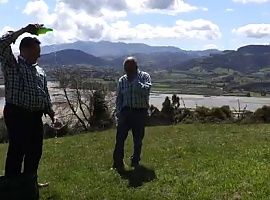Hoy entra en vigor la prohibición de acceso en un área de 20 kilómetros en torno a la central nuclear de Fukushima Daiichi. El ministro portavoz esplicó en rueda de prensa que el estado de la central sigue siendo inestable.
"En repetidas ocasiones hemos pedido al público que se abstenga de entrar en el área de 20 kilometros alrededor de la estación, independientemente de los niveles de radiación, debido a la preocupación de que ello pueda suponer un grave riesgo para la seguridad."
"Como resultado de los esfuerzos de coordinación con los gobiernos interesados ??locales, con base en la Ley Orgánica de Medidas de Control de Desastres, hemos decidido declarar esa zona como zona de prohibición de entrada. Hace un momento, de acuerdo con la Ley de Medidas especiales relativos a la preparación para emergencias nucleares, la organización de Respuesta a Emergencias emitió instrucciones en esta zona para el Gobernador de la prefectura de Fukushima y los alcaldes de ciudades, pueblos y aldeas. La zona se establece como zona de prohibición de entrada a partir de la medianoche del 22 de abril."
"De acuerdo con esta declaración, la entrada en la zona de protección queda prhibida para todos, excepto los que lleven a cabo un trabajo de respuesta de emergencia en la zona, y en casos en los que se concede la entrada temporal por los alcaldes de la región de las ciudades, pueblos y aldeas."
"Es nuestra esperanza que esta medida también ayudará a paliar las preocupaciones que los residentes de la zona tienen sobre la prevención de delitos".
| Urgent installation of generation facilities for securing power supply - Installing new facilities at the site of TEPCO, Kawasaki Thermal Power Station in Kanagawa Prefecture - | |
Currently, amidst our utmost efforts to restore supply capacity, we have decided to install generation facilities such as gas turbine generators at our Kawasaki Thermal Power Station in Kanagawa Prefecture. Accordingly, we would like to announce that we compiled the plan for installing generation facilities today.
For further enhancement of supply capacity, we will examine the installation of generation facilities in a prompt manner. Closely cooperating with the government and requesting customers to reduce electricity consumption, we will continue to make utmost efforts to avoid the rolling blackouts in summer time. |
Detection of Radioactive Materials from Seawater near Fukushima Daiichi Nuclear Power Station
On March 21st, 2011, we conducted sampling surveys, as a part of monitoring
of surrounding environments, and detected radioactive materials in the
seawater around the water discharge canal (of the south side) of Fukushima
Daiichi Nuclear Power Station, which was damaged by the Tohoku - Pacific
Ocean Earthquake. Therefore, we informed Nuclear and Industrial Safety
Agency (NISA) and the government of Fukushima Prefecture of the results.
Since March 22nd, we have conducted seawater sampling surveys at four
points off the shore of Fukushima Daiichi Nuclear Power Station (twice a
day at two points out of such four points since March 26th).
Since April 17, we have also conducted sampling surveys at four points,
3 km off the shore of Fukushima Daiichi Nuclear Power Station, two points,
8 km off the shore of the Power Station and 6 points, 15 km off the shore
of the Power Station and informed them of evaluation results.
The data of three detected nuclides (Iodine-131, Cesium-134 and Cesium-137)
will be reported as fixed data. Other nuclide figures are to be
re-evaluated based on the improved measures for recurrence prevention which
have been prepared in accordance to a warning from NISA on April 1st.
(Previously announced)
On April 20th, 2011, we conducted sampling surveys to evaluate the spread
of radioactive materials to the ocean which were detected at Fukushima
Daiichi Nuclear Power Station. Since the radioactive materials were
detected as shown in the exhibit, we informed NISA and the government of
Fukushima Prefecture of the results.
In addition, we did not conduct any sampling surveys at the twelve points
yesterday on April 20th due to bad weather.
We will continuously conduct the same sampling surveys.





















